Analyzing the Impact of Generation C on Reward Policies and Practices
VerifiedAdded on 2022/12/26
|8
|2051
|84
Essay
AI Summary
This essay delves into the significant impact of Generation C (Gen C) on reward policies and practices within organizations. It begins by defining Gen C as a psychographic group characterized by their tech-savviness, emphasis on connection, curation, community, and creation, contrasting them with previous generations like Gen X, Y, and Z. The essay examines how Gen C's values, such as a healthy work-life balance, a desire for continuous learning, and the importance of social virtualization, are reshaping traditional reward systems. It highlights the shift from monetary rewards and time-off to more flexible and timely advancements, community involvement, and public recognition of achievements. The essay also discusses the influence of mobile technology and the need for organizations to adapt their incentive programs to meet the needs of this new generation, offering insights into how businesses can successfully engage and retain Gen C employees in a changing workplace. The essay also references how Booz & Co. and other organizations are adapting to the changing landscape. The conclusion emphasizes the need for organizations to understand and cater to the unique needs and preferences of Generation C to remain competitive and attract top talent. The essay also analyzes the shift from traditional reward systems and the need for organizations to adapt to the changing landscape.
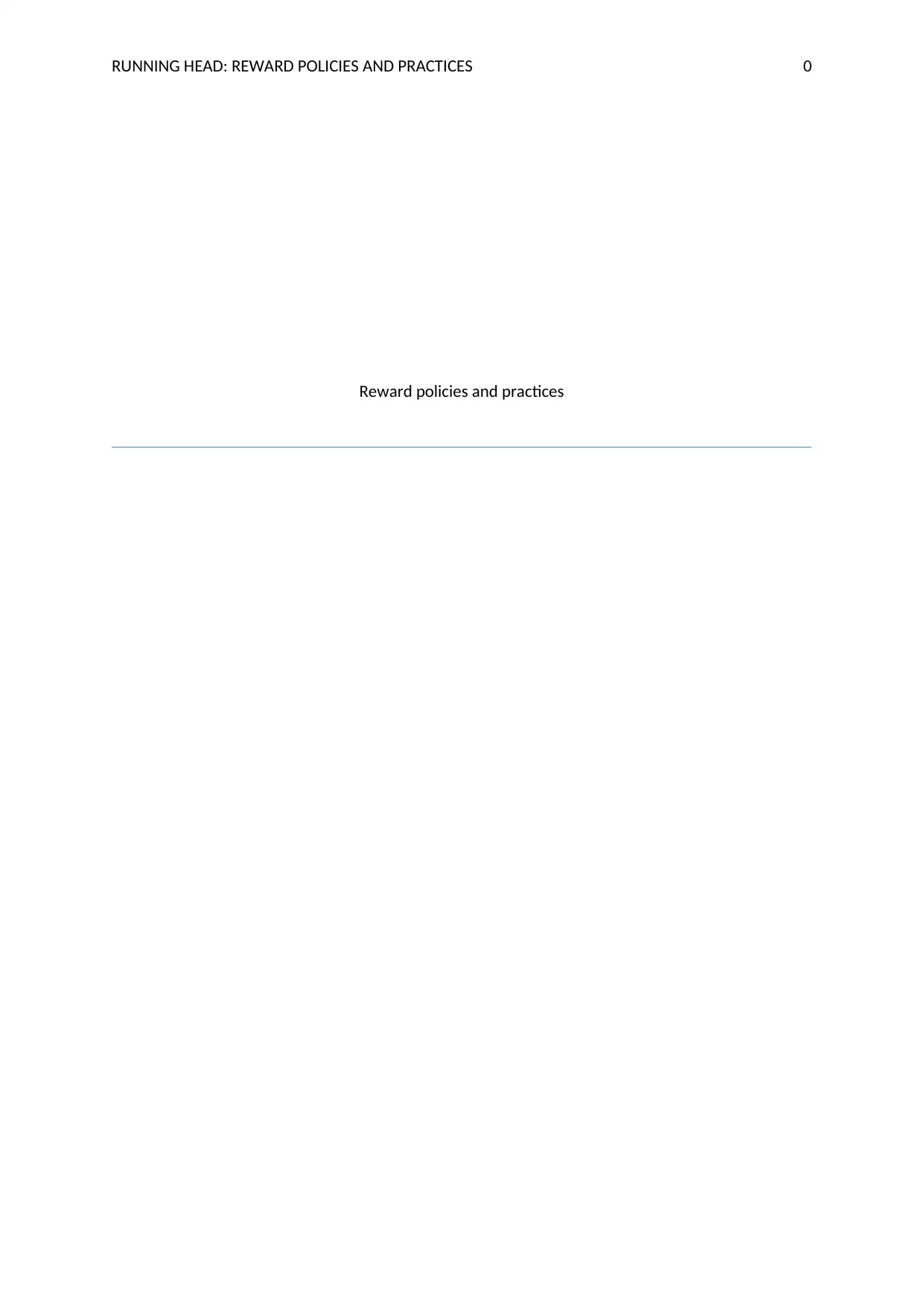
RUNNING HEAD: REWARD POLICIES AND PRACTICES 0
Reward policies and practices
Reward policies and practices
Paraphrase This Document
Need a fresh take? Get an instant paraphrase of this document with our AI Paraphraser
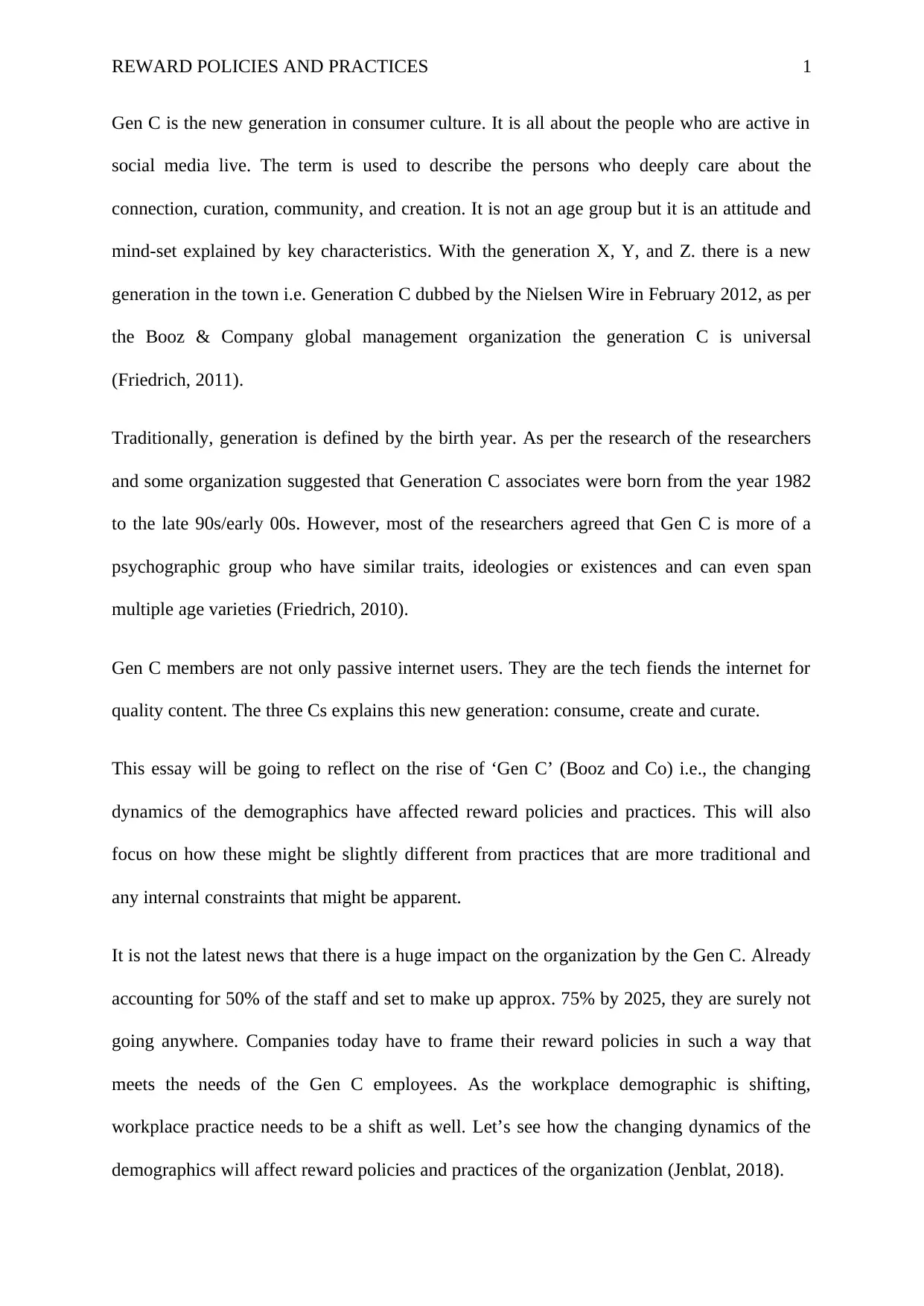
REWARD POLICIES AND PRACTICES 1
Gen C is the new generation in consumer culture. It is all about the people who are active in
social media live. The term is used to describe the persons who deeply care about the
connection, curation, community, and creation. It is not an age group but it is an attitude and
mind-set explained by key characteristics. With the generation X, Y, and Z. there is a new
generation in the town i.e. Generation C dubbed by the Nielsen Wire in February 2012, as per
the Booz & Company global management organization the generation C is universal
(Friedrich, 2011).
Traditionally, generation is defined by the birth year. As per the research of the researchers
and some organization suggested that Generation C associates were born from the year 1982
to the late 90s/early 00s. However, most of the researchers agreed that Gen C is more of a
psychographic group who have similar traits, ideologies or existences and can even span
multiple age varieties (Friedrich, 2010).
Gen C members are not only passive internet users. They are the tech fiends the internet for
quality content. The three Cs explains this new generation: consume, create and curate.
This essay will be going to reflect on the rise of ‘Gen C’ (Booz and Co) i.e., the changing
dynamics of the demographics have affected reward policies and practices. This will also
focus on how these might be slightly different from practices that are more traditional and
any internal constraints that might be apparent.
It is not the latest news that there is a huge impact on the organization by the Gen C. Already
accounting for 50% of the staff and set to make up approx. 75% by 2025, they are surely not
going anywhere. Companies today have to frame their reward policies in such a way that
meets the needs of the Gen C employees. As the workplace demographic is shifting,
workplace practice needs to be a shift as well. Let’s see how the changing dynamics of the
demographics will affect reward policies and practices of the organization (Jenblat, 2018).
Gen C is the new generation in consumer culture. It is all about the people who are active in
social media live. The term is used to describe the persons who deeply care about the
connection, curation, community, and creation. It is not an age group but it is an attitude and
mind-set explained by key characteristics. With the generation X, Y, and Z. there is a new
generation in the town i.e. Generation C dubbed by the Nielsen Wire in February 2012, as per
the Booz & Company global management organization the generation C is universal
(Friedrich, 2011).
Traditionally, generation is defined by the birth year. As per the research of the researchers
and some organization suggested that Generation C associates were born from the year 1982
to the late 90s/early 00s. However, most of the researchers agreed that Gen C is more of a
psychographic group who have similar traits, ideologies or existences and can even span
multiple age varieties (Friedrich, 2010).
Gen C members are not only passive internet users. They are the tech fiends the internet for
quality content. The three Cs explains this new generation: consume, create and curate.
This essay will be going to reflect on the rise of ‘Gen C’ (Booz and Co) i.e., the changing
dynamics of the demographics have affected reward policies and practices. This will also
focus on how these might be slightly different from practices that are more traditional and
any internal constraints that might be apparent.
It is not the latest news that there is a huge impact on the organization by the Gen C. Already
accounting for 50% of the staff and set to make up approx. 75% by 2025, they are surely not
going anywhere. Companies today have to frame their reward policies in such a way that
meets the needs of the Gen C employees. As the workplace demographic is shifting,
workplace practice needs to be a shift as well. Let’s see how the changing dynamics of the
demographics will affect reward policies and practices of the organization (Jenblat, 2018).
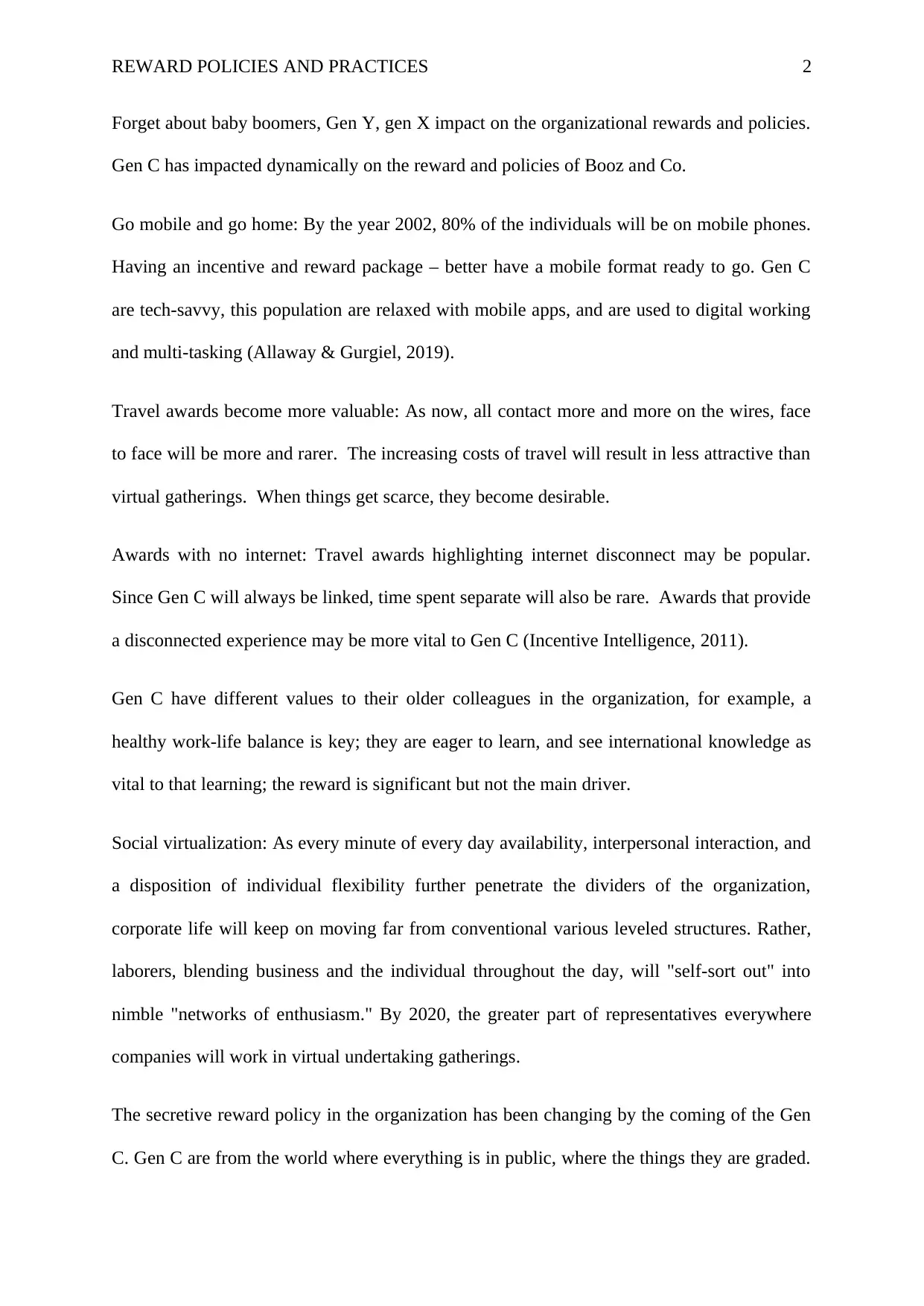
REWARD POLICIES AND PRACTICES 2
Forget about baby boomers, Gen Y, gen X impact on the organizational rewards and policies.
Gen C has impacted dynamically on the reward and policies of Booz and Co.
Go mobile and go home: By the year 2002, 80% of the individuals will be on mobile phones.
Having an incentive and reward package – better have a mobile format ready to go. Gen C
are tech-savvy, this population are relaxed with mobile apps, and are used to digital working
and multi-tasking (Allaway & Gurgiel, 2019).
Travel awards become more valuable: As now, all contact more and more on the wires, face
to face will be more and rarer. The increasing costs of travel will result in less attractive than
virtual gatherings. When things get scarce, they become desirable.
Awards with no internet: Travel awards highlighting internet disconnect may be popular.
Since Gen C will always be linked, time spent separate will also be rare. Awards that provide
a disconnected experience may be more vital to Gen C (Incentive Intelligence, 2011).
Gen C have different values to their older colleagues in the organization, for example, a
healthy work-life balance is key; they are eager to learn, and see international knowledge as
vital to that learning; the reward is significant but not the main driver.
Social virtualization: As every minute of every day availability, interpersonal interaction, and
a disposition of individual flexibility further penetrate the dividers of the organization,
corporate life will keep on moving far from conventional various leveled structures. Rather,
laborers, blending business and the individual throughout the day, will "self-sort out" into
nimble "networks of enthusiasm." By 2020, the greater part of representatives everywhere
companies will work in virtual undertaking gatherings.
The secretive reward policy in the organization has been changing by the coming of the Gen
C. Gen C are from the world where everything is in public, where the things they are graded.
Forget about baby boomers, Gen Y, gen X impact on the organizational rewards and policies.
Gen C has impacted dynamically on the reward and policies of Booz and Co.
Go mobile and go home: By the year 2002, 80% of the individuals will be on mobile phones.
Having an incentive and reward package – better have a mobile format ready to go. Gen C
are tech-savvy, this population are relaxed with mobile apps, and are used to digital working
and multi-tasking (Allaway & Gurgiel, 2019).
Travel awards become more valuable: As now, all contact more and more on the wires, face
to face will be more and rarer. The increasing costs of travel will result in less attractive than
virtual gatherings. When things get scarce, they become desirable.
Awards with no internet: Travel awards highlighting internet disconnect may be popular.
Since Gen C will always be linked, time spent separate will also be rare. Awards that provide
a disconnected experience may be more vital to Gen C (Incentive Intelligence, 2011).
Gen C have different values to their older colleagues in the organization, for example, a
healthy work-life balance is key; they are eager to learn, and see international knowledge as
vital to that learning; the reward is significant but not the main driver.
Social virtualization: As every minute of every day availability, interpersonal interaction, and
a disposition of individual flexibility further penetrate the dividers of the organization,
corporate life will keep on moving far from conventional various leveled structures. Rather,
laborers, blending business and the individual throughout the day, will "self-sort out" into
nimble "networks of enthusiasm." By 2020, the greater part of representatives everywhere
companies will work in virtual undertaking gatherings.
The secretive reward policy in the organization has been changing by the coming of the Gen
C. Gen C are from the world where everything is in public, where the things they are graded.
⊘ This is a preview!⊘
Do you want full access?
Subscribe today to unlock all pages.

Trusted by 1+ million students worldwide
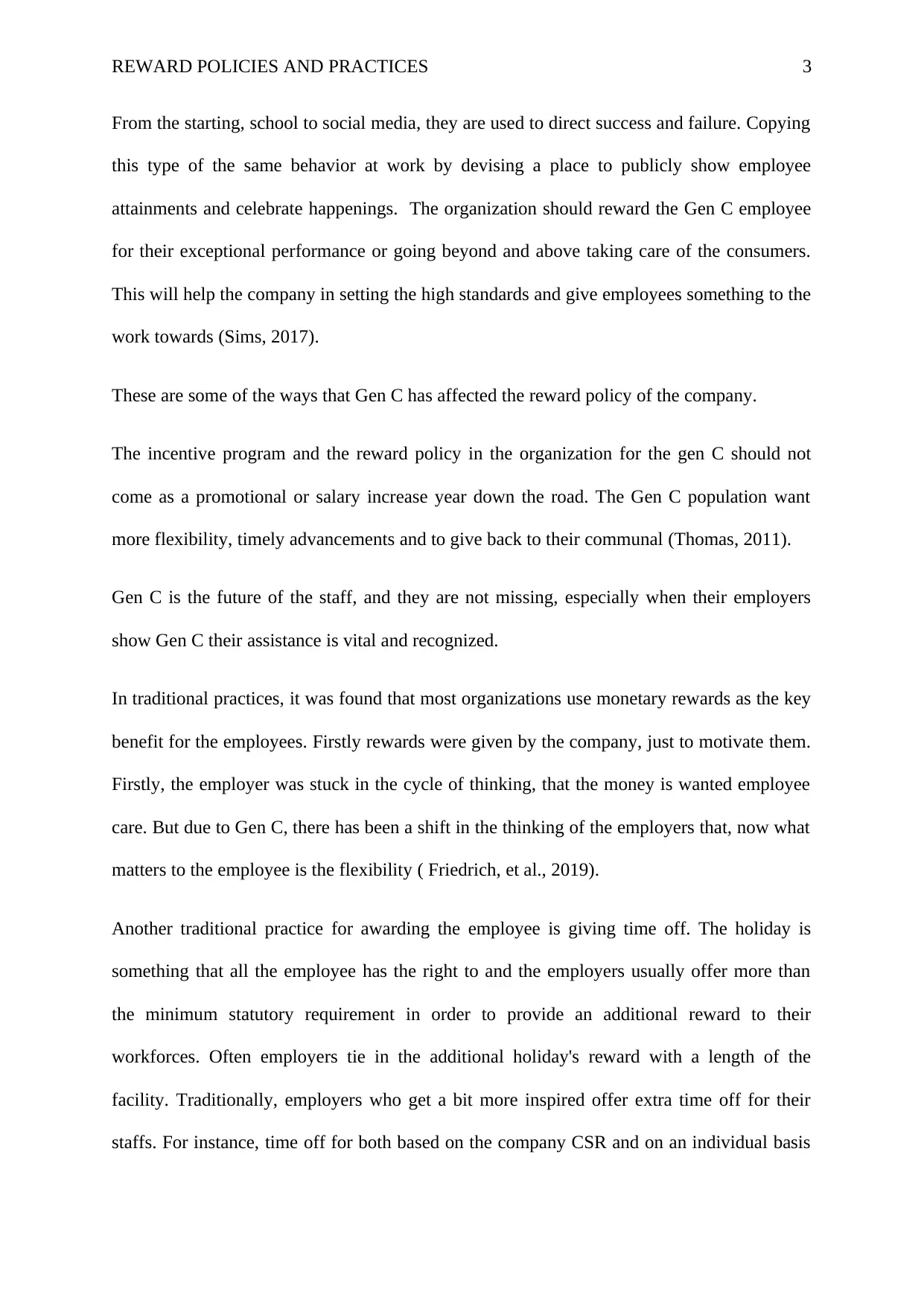
REWARD POLICIES AND PRACTICES 3
From the starting, school to social media, they are used to direct success and failure. Copying
this type of the same behavior at work by devising a place to publicly show employee
attainments and celebrate happenings. The organization should reward the Gen C employee
for their exceptional performance or going beyond and above taking care of the consumers.
This will help the company in setting the high standards and give employees something to the
work towards (Sims, 2017).
These are some of the ways that Gen C has affected the reward policy of the company.
The incentive program and the reward policy in the organization for the gen C should not
come as a promotional or salary increase year down the road. The Gen C population want
more flexibility, timely advancements and to give back to their communal (Thomas, 2011).
Gen C is the future of the staff, and they are not missing, especially when their employers
show Gen C their assistance is vital and recognized.
In traditional practices, it was found that most organizations use monetary rewards as the key
benefit for the employees. Firstly rewards were given by the company, just to motivate them.
Firstly, the employer was stuck in the cycle of thinking, that the money is wanted employee
care. But due to Gen C, there has been a shift in the thinking of the employers that, now what
matters to the employee is the flexibility ( Friedrich, et al., 2019).
Another traditional practice for awarding the employee is giving time off. The holiday is
something that all the employee has the right to and the employers usually offer more than
the minimum statutory requirement in order to provide an additional reward to their
workforces. Often employers tie in the additional holiday's reward with a length of the
facility. Traditionally, employers who get a bit more inspired offer extra time off for their
staffs. For instance, time off for both based on the company CSR and on an individual basis
From the starting, school to social media, they are used to direct success and failure. Copying
this type of the same behavior at work by devising a place to publicly show employee
attainments and celebrate happenings. The organization should reward the Gen C employee
for their exceptional performance or going beyond and above taking care of the consumers.
This will help the company in setting the high standards and give employees something to the
work towards (Sims, 2017).
These are some of the ways that Gen C has affected the reward policy of the company.
The incentive program and the reward policy in the organization for the gen C should not
come as a promotional or salary increase year down the road. The Gen C population want
more flexibility, timely advancements and to give back to their communal (Thomas, 2011).
Gen C is the future of the staff, and they are not missing, especially when their employers
show Gen C their assistance is vital and recognized.
In traditional practices, it was found that most organizations use monetary rewards as the key
benefit for the employees. Firstly rewards were given by the company, just to motivate them.
Firstly, the employer was stuck in the cycle of thinking, that the money is wanted employee
care. But due to Gen C, there has been a shift in the thinking of the employers that, now what
matters to the employee is the flexibility ( Friedrich, et al., 2019).
Another traditional practice for awarding the employee is giving time off. The holiday is
something that all the employee has the right to and the employers usually offer more than
the minimum statutory requirement in order to provide an additional reward to their
workforces. Often employers tie in the additional holiday's reward with a length of the
facility. Traditionally, employers who get a bit more inspired offer extra time off for their
staffs. For instance, time off for both based on the company CSR and on an individual basis
Paraphrase This Document
Need a fresh take? Get an instant paraphrase of this document with our AI Paraphraser
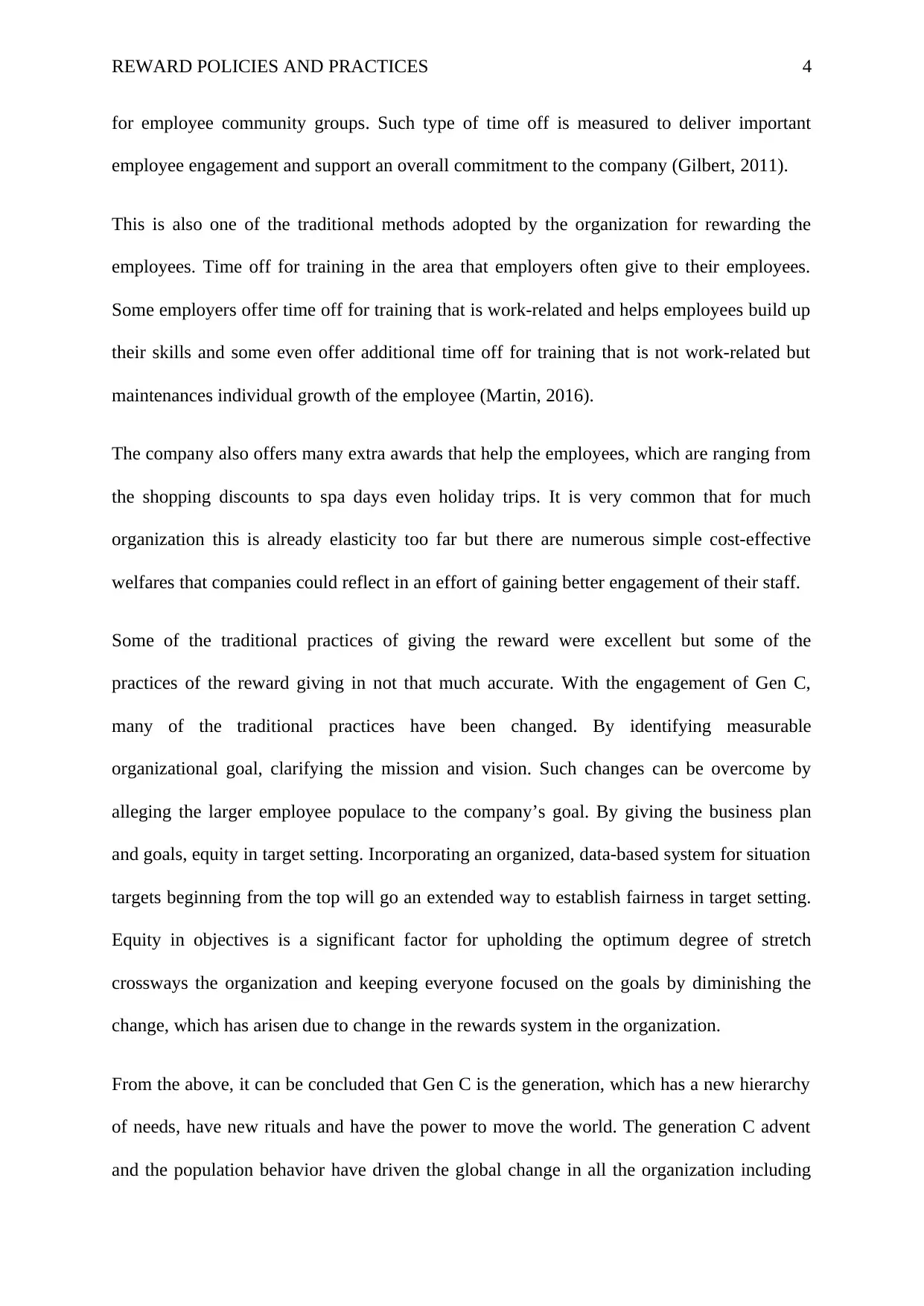
REWARD POLICIES AND PRACTICES 4
for employee community groups. Such type of time off is measured to deliver important
employee engagement and support an overall commitment to the company (Gilbert, 2011).
This is also one of the traditional methods adopted by the organization for rewarding the
employees. Time off for training in the area that employers often give to their employees.
Some employers offer time off for training that is work-related and helps employees build up
their skills and some even offer additional time off for training that is not work-related but
maintenances individual growth of the employee (Martin, 2016).
The company also offers many extra awards that help the employees, which are ranging from
the shopping discounts to spa days even holiday trips. It is very common that for much
organization this is already elasticity too far but there are numerous simple cost-effective
welfares that companies could reflect in an effort of gaining better engagement of their staff.
Some of the traditional practices of giving the reward were excellent but some of the
practices of the reward giving in not that much accurate. With the engagement of Gen C,
many of the traditional practices have been changed. By identifying measurable
organizational goal, clarifying the mission and vision. Such changes can be overcome by
alleging the larger employee populace to the company’s goal. By giving the business plan
and goals, equity in target setting. Incorporating an organized, data-based system for situation
targets beginning from the top will go an extended way to establish fairness in target setting.
Equity in objectives is a significant factor for upholding the optimum degree of stretch
crossways the organization and keeping everyone focused on the goals by diminishing the
change, which has arisen due to change in the rewards system in the organization.
From the above, it can be concluded that Gen C is the generation, which has a new hierarchy
of needs, have new rituals and have the power to move the world. The generation C advent
and the population behavior have driven the global change in all the organization including
for employee community groups. Such type of time off is measured to deliver important
employee engagement and support an overall commitment to the company (Gilbert, 2011).
This is also one of the traditional methods adopted by the organization for rewarding the
employees. Time off for training in the area that employers often give to their employees.
Some employers offer time off for training that is work-related and helps employees build up
their skills and some even offer additional time off for training that is not work-related but
maintenances individual growth of the employee (Martin, 2016).
The company also offers many extra awards that help the employees, which are ranging from
the shopping discounts to spa days even holiday trips. It is very common that for much
organization this is already elasticity too far but there are numerous simple cost-effective
welfares that companies could reflect in an effort of gaining better engagement of their staff.
Some of the traditional practices of giving the reward were excellent but some of the
practices of the reward giving in not that much accurate. With the engagement of Gen C,
many of the traditional practices have been changed. By identifying measurable
organizational goal, clarifying the mission and vision. Such changes can be overcome by
alleging the larger employee populace to the company’s goal. By giving the business plan
and goals, equity in target setting. Incorporating an organized, data-based system for situation
targets beginning from the top will go an extended way to establish fairness in target setting.
Equity in objectives is a significant factor for upholding the optimum degree of stretch
crossways the organization and keeping everyone focused on the goals by diminishing the
change, which has arisen due to change in the rewards system in the organization.
From the above, it can be concluded that Gen C is the generation, which has a new hierarchy
of needs, have new rituals and have the power to move the world. The generation C advent
and the population behavior have driven the global change in all the organization including
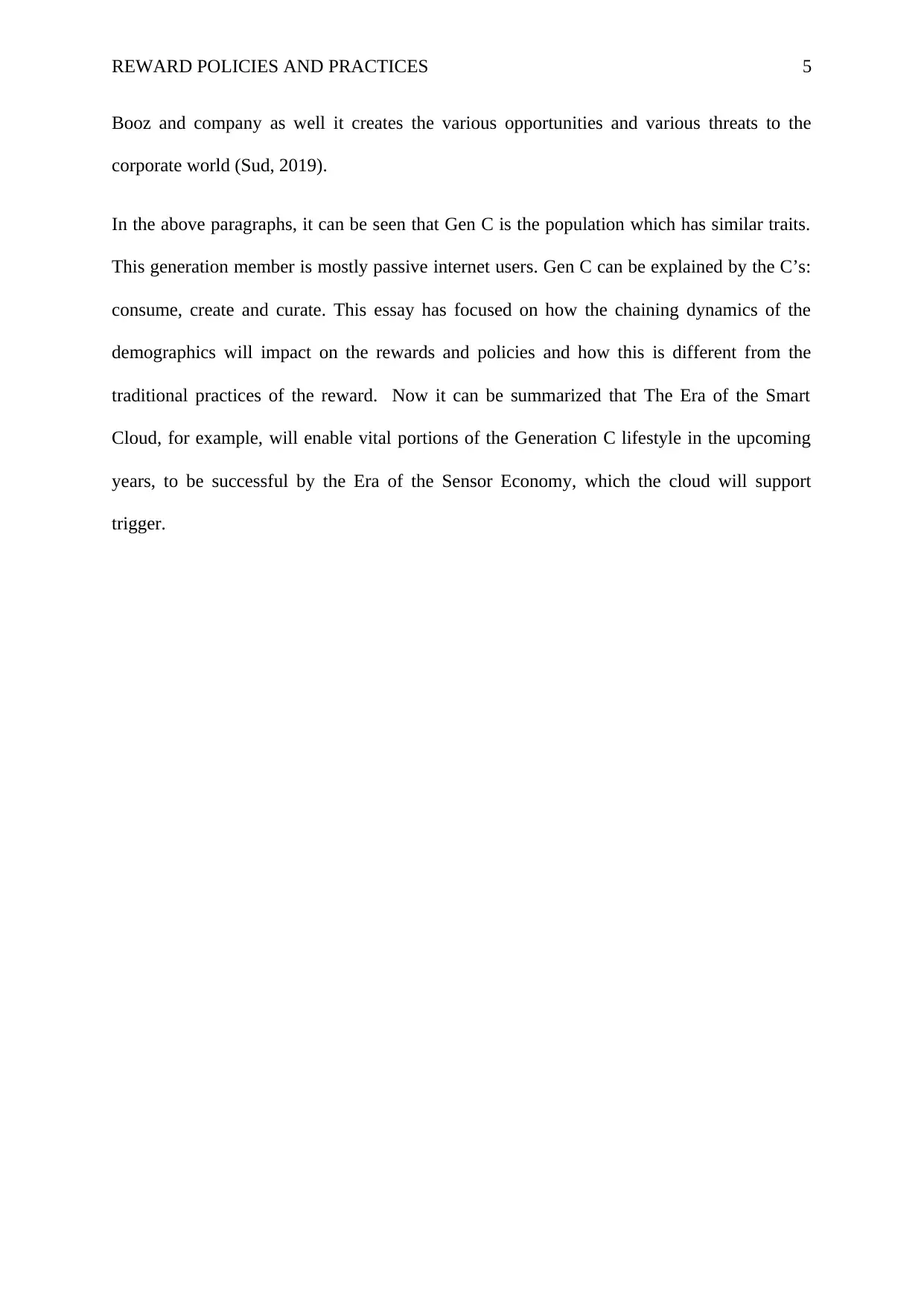
REWARD POLICIES AND PRACTICES 5
Booz and company as well it creates the various opportunities and various threats to the
corporate world (Sud, 2019).
In the above paragraphs, it can be seen that Gen C is the population which has similar traits.
This generation member is mostly passive internet users. Gen C can be explained by the C’s:
consume, create and curate. This essay has focused on how the chaining dynamics of the
demographics will impact on the rewards and policies and how this is different from the
traditional practices of the reward. Now it can be summarized that The Era of the Smart
Cloud, for example, will enable vital portions of the Generation C lifestyle in the upcoming
years, to be successful by the Era of the Sensor Economy, which the cloud will support
trigger.
Booz and company as well it creates the various opportunities and various threats to the
corporate world (Sud, 2019).
In the above paragraphs, it can be seen that Gen C is the population which has similar traits.
This generation member is mostly passive internet users. Gen C can be explained by the C’s:
consume, create and curate. This essay has focused on how the chaining dynamics of the
demographics will impact on the rewards and policies and how this is different from the
traditional practices of the reward. Now it can be summarized that The Era of the Smart
Cloud, for example, will enable vital portions of the Generation C lifestyle in the upcoming
years, to be successful by the Era of the Sensor Economy, which the cloud will support
trigger.
⊘ This is a preview!⊘
Do you want full access?
Subscribe today to unlock all pages.

Trusted by 1+ million students worldwide
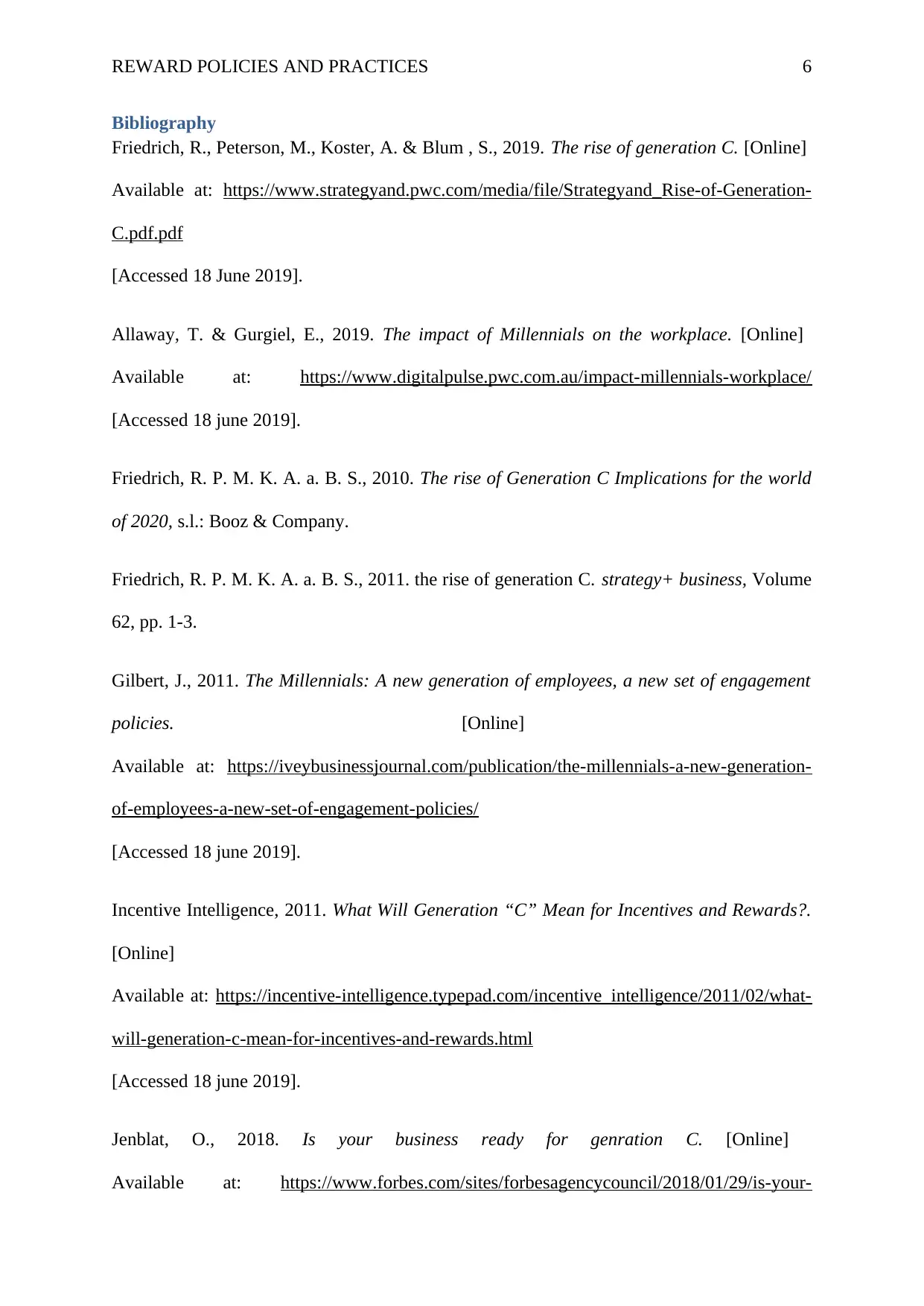
REWARD POLICIES AND PRACTICES 6
Bibliography
Friedrich, R., Peterson, M., Koster, A. & Blum , S., 2019. The rise of generation C. [Online]
Available at: https://www.strategyand.pwc.com/media/file/Strategyand_Rise-of-Generation-
C.pdf.pdf
[Accessed 18 June 2019].
Allaway, T. & Gurgiel, E., 2019. The impact of Millennials on the workplace. [Online]
Available at: https://www.digitalpulse.pwc.com.au/impact-millennials-workplace/
[Accessed 18 june 2019].
Friedrich, R. P. M. K. A. a. B. S., 2010. The rise of Generation C Implications for the world
of 2020, s.l.: Booz & Company.
Friedrich, R. P. M. K. A. a. B. S., 2011. the rise of generation C. strategy+ business, Volume
62, pp. 1-3.
Gilbert, J., 2011. The Millennials: A new generation of employees, a new set of engagement
policies. [Online]
Available at: https://iveybusinessjournal.com/publication/the-millennials-a-new-generation-
of-employees-a-new-set-of-engagement-policies/
[Accessed 18 june 2019].
Incentive Intelligence, 2011. What Will Generation “C” Mean for Incentives and Rewards?.
[Online]
Available at: https://incentive-intelligence.typepad.com/incentive_intelligence/2011/02/what-
will-generation-c-mean-for-incentives-and-rewards.html
[Accessed 18 june 2019].
Jenblat, O., 2018. Is your business ready for genration C. [Online]
Available at: https://www.forbes.com/sites/forbesagencycouncil/2018/01/29/is-your-
Bibliography
Friedrich, R., Peterson, M., Koster, A. & Blum , S., 2019. The rise of generation C. [Online]
Available at: https://www.strategyand.pwc.com/media/file/Strategyand_Rise-of-Generation-
C.pdf.pdf
[Accessed 18 June 2019].
Allaway, T. & Gurgiel, E., 2019. The impact of Millennials on the workplace. [Online]
Available at: https://www.digitalpulse.pwc.com.au/impact-millennials-workplace/
[Accessed 18 june 2019].
Friedrich, R. P. M. K. A. a. B. S., 2010. The rise of Generation C Implications for the world
of 2020, s.l.: Booz & Company.
Friedrich, R. P. M. K. A. a. B. S., 2011. the rise of generation C. strategy+ business, Volume
62, pp. 1-3.
Gilbert, J., 2011. The Millennials: A new generation of employees, a new set of engagement
policies. [Online]
Available at: https://iveybusinessjournal.com/publication/the-millennials-a-new-generation-
of-employees-a-new-set-of-engagement-policies/
[Accessed 18 june 2019].
Incentive Intelligence, 2011. What Will Generation “C” Mean for Incentives and Rewards?.
[Online]
Available at: https://incentive-intelligence.typepad.com/incentive_intelligence/2011/02/what-
will-generation-c-mean-for-incentives-and-rewards.html
[Accessed 18 june 2019].
Jenblat, O., 2018. Is your business ready for genration C. [Online]
Available at: https://www.forbes.com/sites/forbesagencycouncil/2018/01/29/is-your-
Paraphrase This Document
Need a fresh take? Get an instant paraphrase of this document with our AI Paraphraser
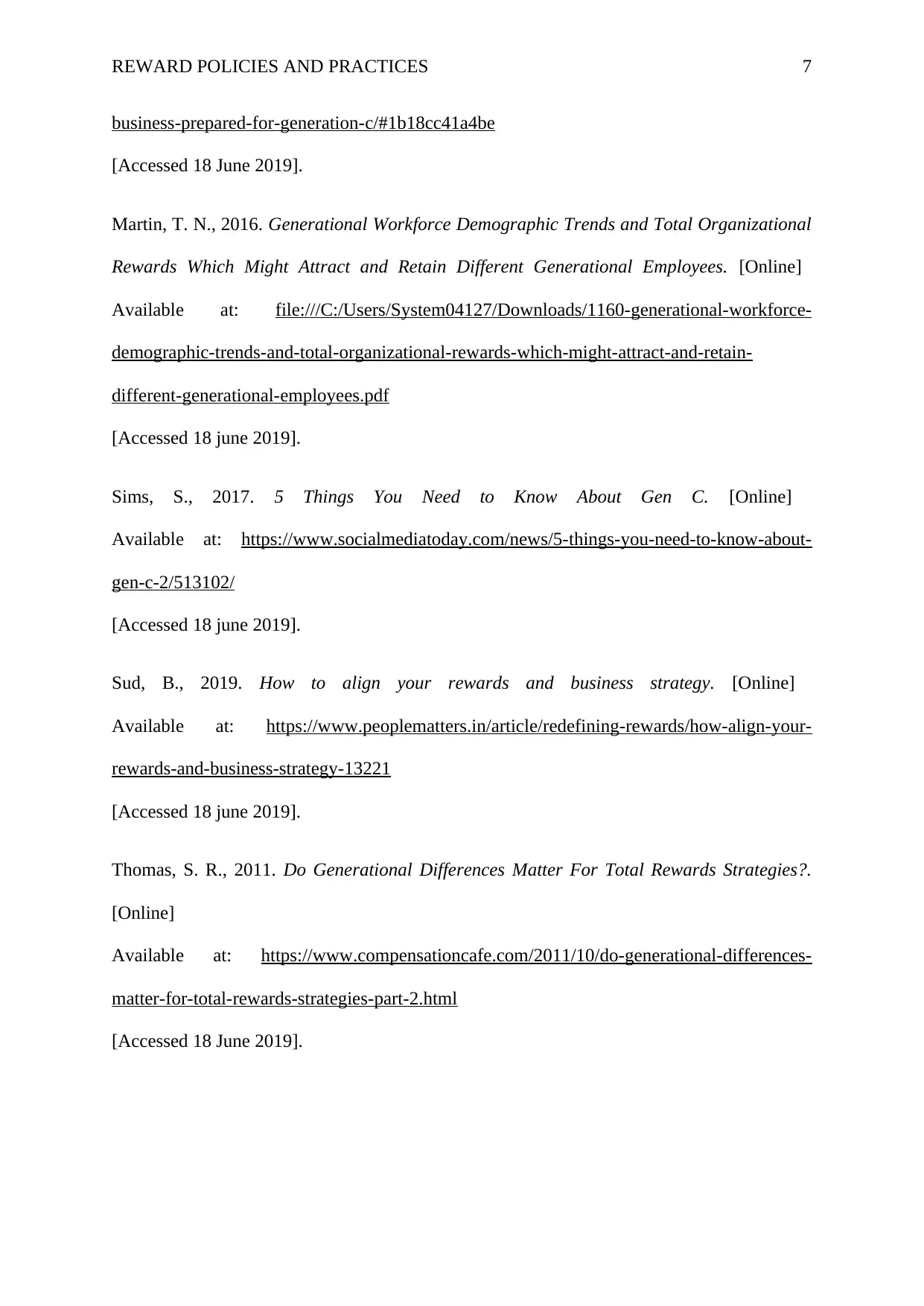
REWARD POLICIES AND PRACTICES 7
business-prepared-for-generation-c/#1b18cc41a4be
[Accessed 18 June 2019].
Martin, T. N., 2016. Generational Workforce Demographic Trends and Total Organizational
Rewards Which Might Attract and Retain Different Generational Employees. [Online]
Available at: file:///C:/Users/System04127/Downloads/1160-generational-workforce-
demographic-trends-and-total-organizational-rewards-which-might-attract-and-retain-
different-generational-employees.pdf
[Accessed 18 june 2019].
Sims, S., 2017. 5 Things You Need to Know About Gen C. [Online]
Available at: https://www.socialmediatoday.com/news/5-things-you-need-to-know-about-
gen-c-2/513102/
[Accessed 18 june 2019].
Sud, B., 2019. How to align your rewards and business strategy. [Online]
Available at: https://www.peoplematters.in/article/redefining-rewards/how-align-your-
rewards-and-business-strategy-13221
[Accessed 18 june 2019].
Thomas, S. R., 2011. Do Generational Differences Matter For Total Rewards Strategies?.
[Online]
Available at: https://www.compensationcafe.com/2011/10/do-generational-differences-
matter-for-total-rewards-strategies-part-2.html
[Accessed 18 June 2019].
business-prepared-for-generation-c/#1b18cc41a4be
[Accessed 18 June 2019].
Martin, T. N., 2016. Generational Workforce Demographic Trends and Total Organizational
Rewards Which Might Attract and Retain Different Generational Employees. [Online]
Available at: file:///C:/Users/System04127/Downloads/1160-generational-workforce-
demographic-trends-and-total-organizational-rewards-which-might-attract-and-retain-
different-generational-employees.pdf
[Accessed 18 june 2019].
Sims, S., 2017. 5 Things You Need to Know About Gen C. [Online]
Available at: https://www.socialmediatoday.com/news/5-things-you-need-to-know-about-
gen-c-2/513102/
[Accessed 18 june 2019].
Sud, B., 2019. How to align your rewards and business strategy. [Online]
Available at: https://www.peoplematters.in/article/redefining-rewards/how-align-your-
rewards-and-business-strategy-13221
[Accessed 18 june 2019].
Thomas, S. R., 2011. Do Generational Differences Matter For Total Rewards Strategies?.
[Online]
Available at: https://www.compensationcafe.com/2011/10/do-generational-differences-
matter-for-total-rewards-strategies-part-2.html
[Accessed 18 June 2019].
1 out of 8
Your All-in-One AI-Powered Toolkit for Academic Success.
+13062052269
info@desklib.com
Available 24*7 on WhatsApp / Email
![[object Object]](/_next/static/media/star-bottom.7253800d.svg)
Unlock your academic potential
Copyright © 2020–2025 A2Z Services. All Rights Reserved. Developed and managed by ZUCOL.